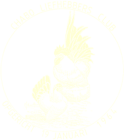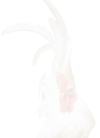|
|
|
|
 |
| |
| |
| The
little Chabo cock |
| in "the
Poultry Yard" by
Jan Steen |
| |
| -
continued 2 - |
| |
|
|
|
|
|
The
forming of a crest in stead of a comb
is, certainly seen phenotypically, a
radical change in the fowl. It changes
the form of the skull by means of a bump
formed raising, to offer space as for
real to all the feathers that will grow
on that spot. This change is perceived
best in the little chickens. |
|
|
|
|
|
|
|
It
is not the case that by crossing fowl
with a single comb and a crested chicken
a complete tuft has been created
immediately in the next generation. A
large scale of in between forms, one
better successful than the other, is
shown, provided a large number of
descendants. To understand this
better the presentation as by the Houdan
is best, a fowl described for the first
time in the seventeenth century, so in
the same period of time in which Jan
Steen painted "The Poultry
Yard". This Northern-French
(Norman) breed got stuck, so to say,
somewhere in the middle of the
development from a fowl with a single
comb to a full crested one. Seen this
way it is also understandable that
Darwin, apparently only judging the
crest forms, has considered this breed
with a fifth toe, together with the Crève Coeur,
also a bearded Norman breed, but with a
much better developed crest, and
together with the wattled Polish, or as
is said in the Netherlands: the Dutch
Crested Fowl, to be subspecies of one
and the same variety. For that matter,
we should not forget in this all that as
well the Houdan as the Crève Coeur
originally not were meant as decorative
fowl but as animals for use with
priorities as laying eggs and providing tasteful
meat. |
|
|
|
|
|
|
 |
|
|
|
|
| |
|
|
|
However,
it is remarkable that when crossing single combed fowl
with crested fowl there also a 'doubling' of the comb
appears in the in between forms of the combs, with the
understanding that the remaining comb shows the form of
'antlers' or a crown comb. A form that in the end
has been perfected in the Dutch Crested Fowl (the
Polish) into a feathered 'butterfly' over the bill.
|
|
This
'doubled in between form of comb' can be
perceived well in the descendant in the image
here below of a Chabo father (with wrong
coloured legs) and his bastard son. The
similarities with the Houdan, and in a way also
with the Crève Coeur, are striking with regard
to the form of the comb and crest.
|
|
|
|
|
|
|
|
If
we have a look again at Steen's little cock than
immediately the 'in between comb form' can be
seen now of the second grotesque midget,
although less shabby attired, on the painting.
Because now also some light has been shed on its
presumptuous origin, the appellation of Steen's
little cock as a Chabo x Crested (&
Bearded) Fowl bastard is not so difficult
anymore.
|
|
The
discussions about the right naming of the breed
of Steen's little cock will undoubtedly not be
ended here, with which as well the painting of Jan
Steen, as also the breeding of decorative fowl
and in particular the Chabos or Japanese bantams
an as also the possibilities of interesting
discussion are honoured, but anyway there has
now in the mean time been brought forward more
matter to consider.
|
|
'click'
here to return to the main page...
|
|
|
|
|
|
|
|
|
|
|
|
|
|
|
 |
|
|
|
|
|
|
|
|
|
|
|
|
|
|
|
|
|
|
|
|
|
| [
The
"Poultry-yard" by Jan Steen, 1660 ] |
|
| [
Home page
>
the
C.L.C. > the
Chabo
>
the Chabo, Chabo's
in the Netherlands
> note
> (note)
continuation-1> (note)
continued-2
] |
|

|
|
|